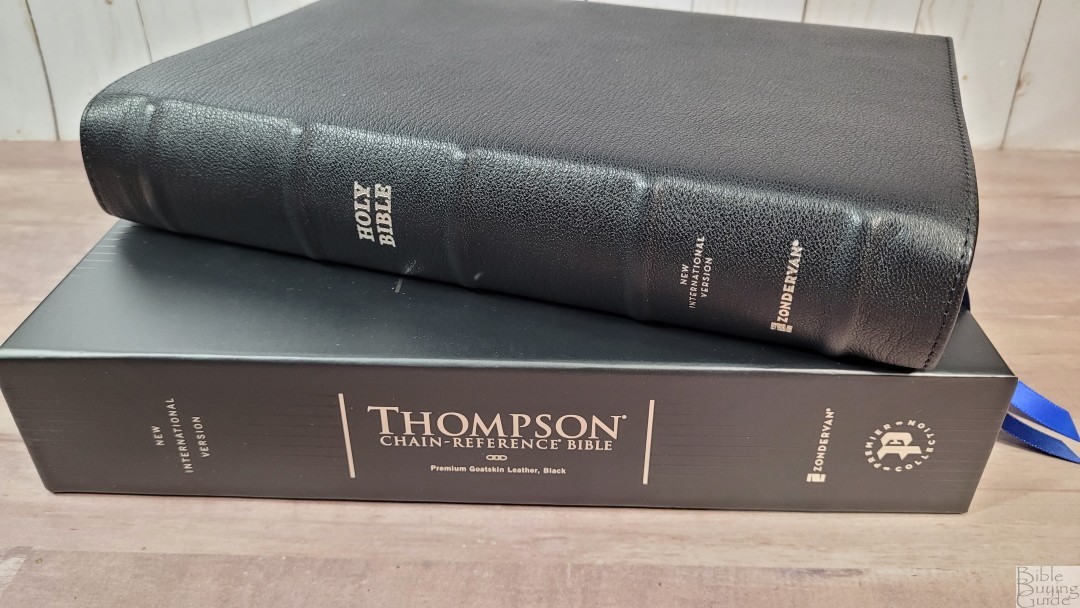
Zondervan’s first updated Thompson Chain Reference Bible is the NIV, typeset with the NIV Comfort Print typeface designed by 2K/Denmark. I’ve covered the design and size comparisons in previous reviews. This review will focus on the Premier Collection version of the new TCR. I’ve included the layout information from the first review with the information and photos of the goatskin (Premier Collection) edition. It was typeset by 2K/Denmark and printed in China.
Zondervan provided this Bible in exchange for an honest review. I was not required to give a positive review, only an honest one. All opinions are my own.
_________________________________________________________
This Bible is available from
Church Source (available soon)
_________________________________________________________
Table of Contents
Video Review
Goatskin Cover
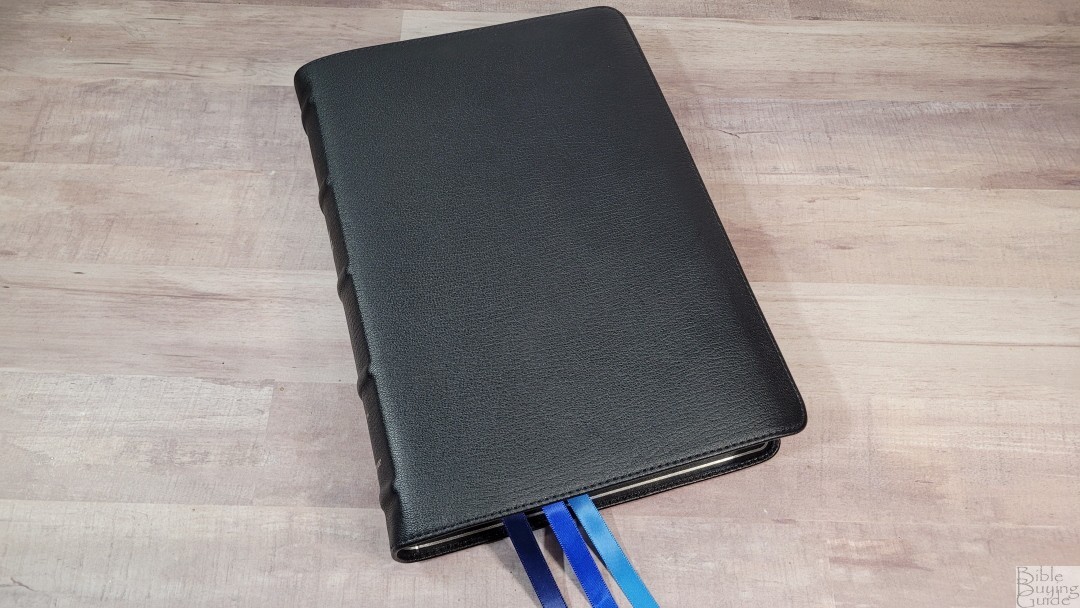
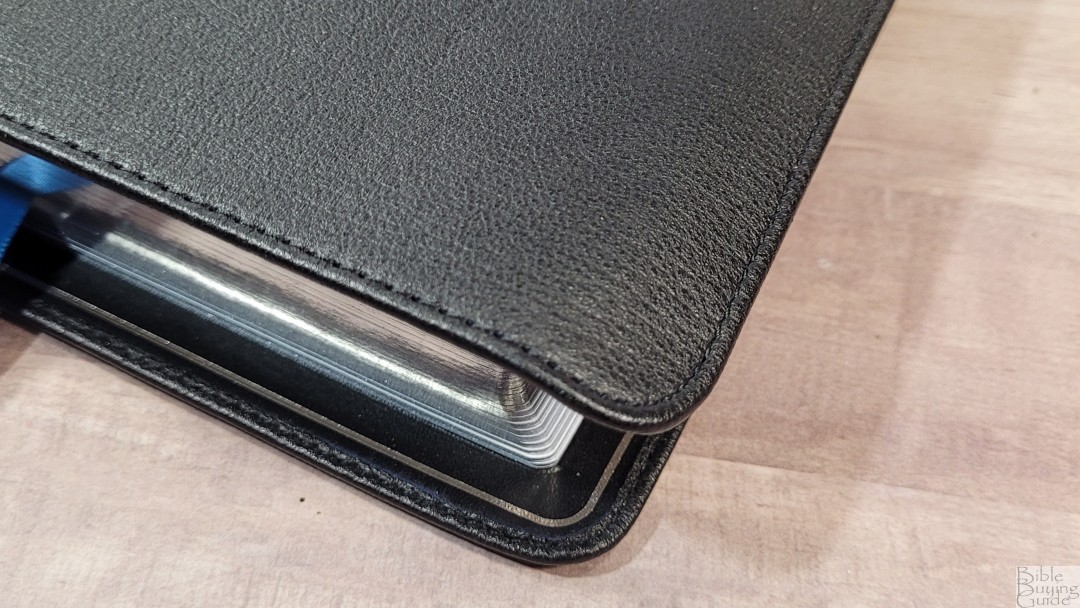
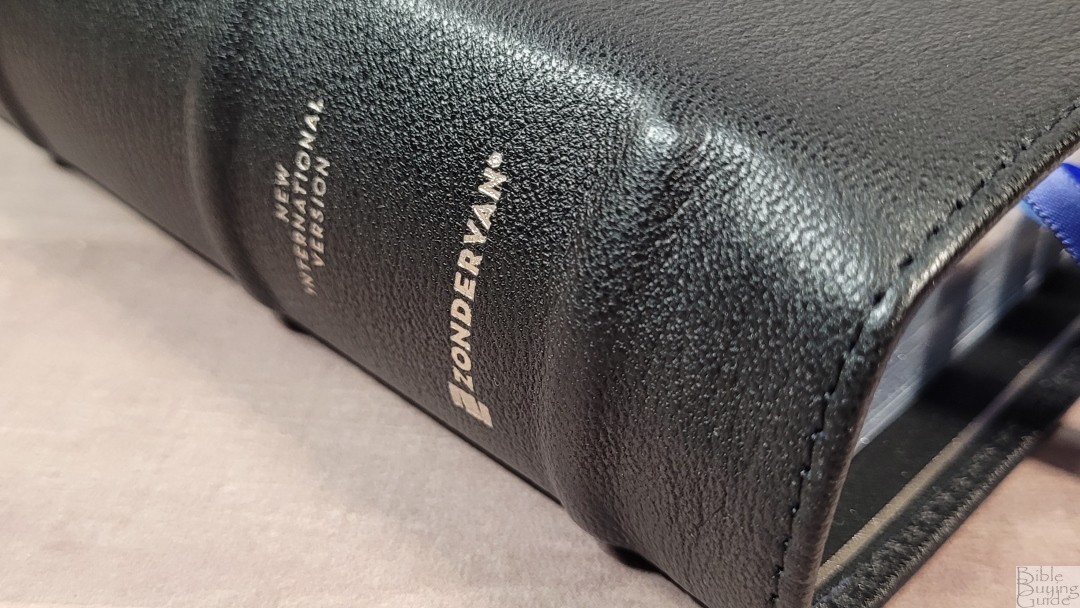
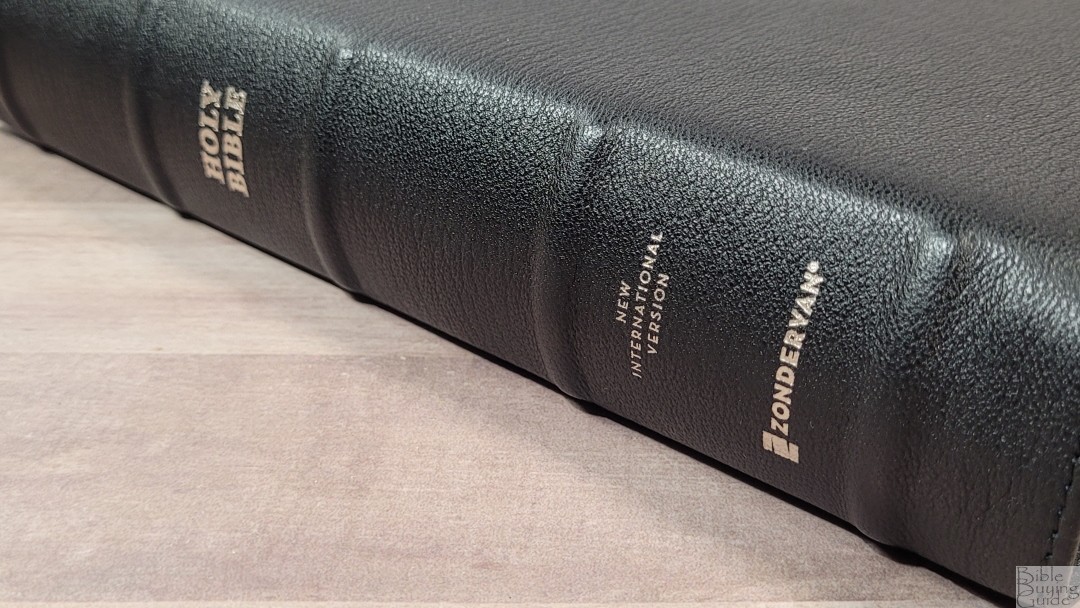
The goatskin is a thick leather that looks and feels elegant. It has a matte finish and an almost pebbly grain that you can feel. The yapp is 1/2″. It includes perimeter stitching. Nothing is printed on the front. The spine has 5 raised hubs. Text is printed in silver.
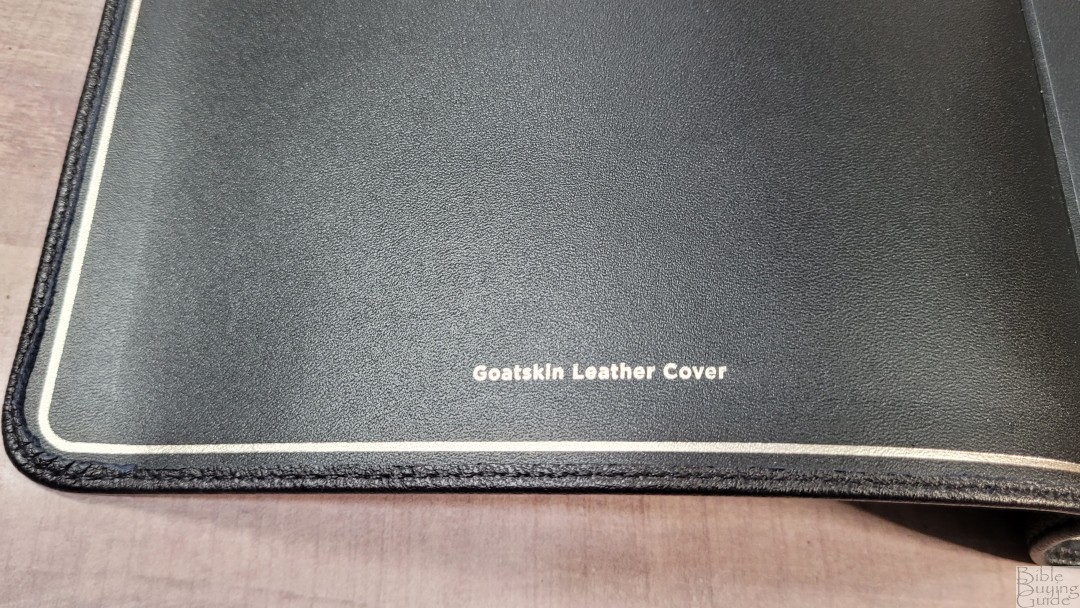
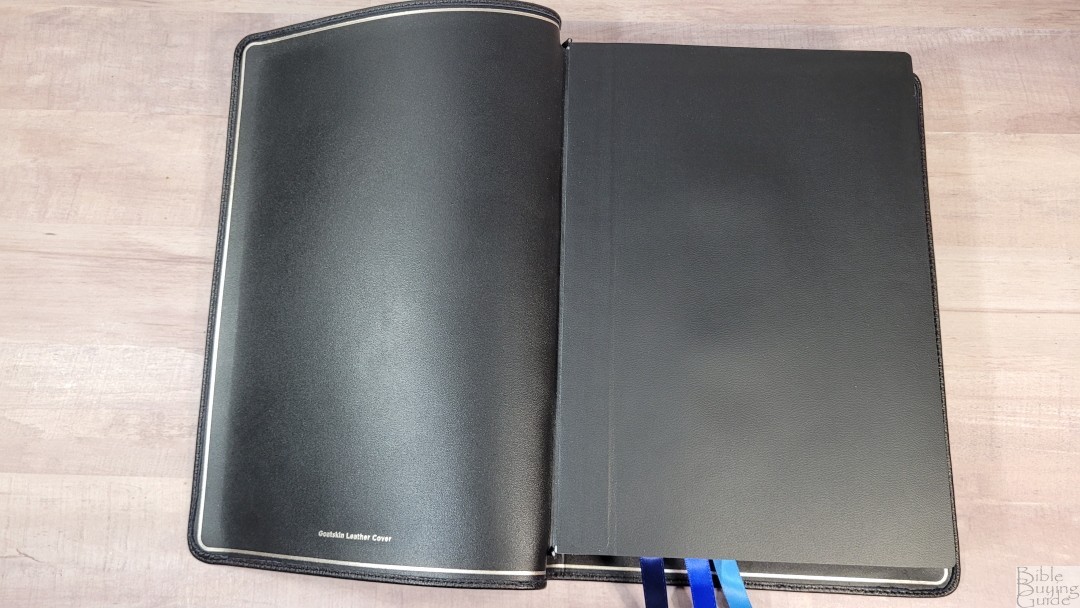
The edge-lined liner is also leather. It includes a gilt line around the inside perimeter. The tab isn’t as stiff as other editions I’ve seen in the Premier Collection. It stays open flat in Genesis 1 with no trouble.
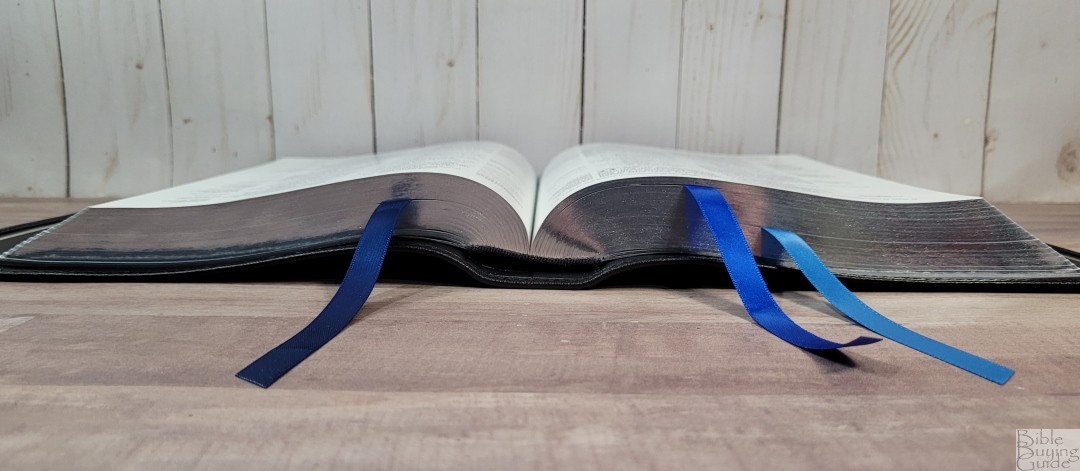
This edition has three ribbons, each is a different shade of blue. Premier Collection – 7 x 9 3/4 x 1 3/4″, it weighs 3 lbs, 11 oz.
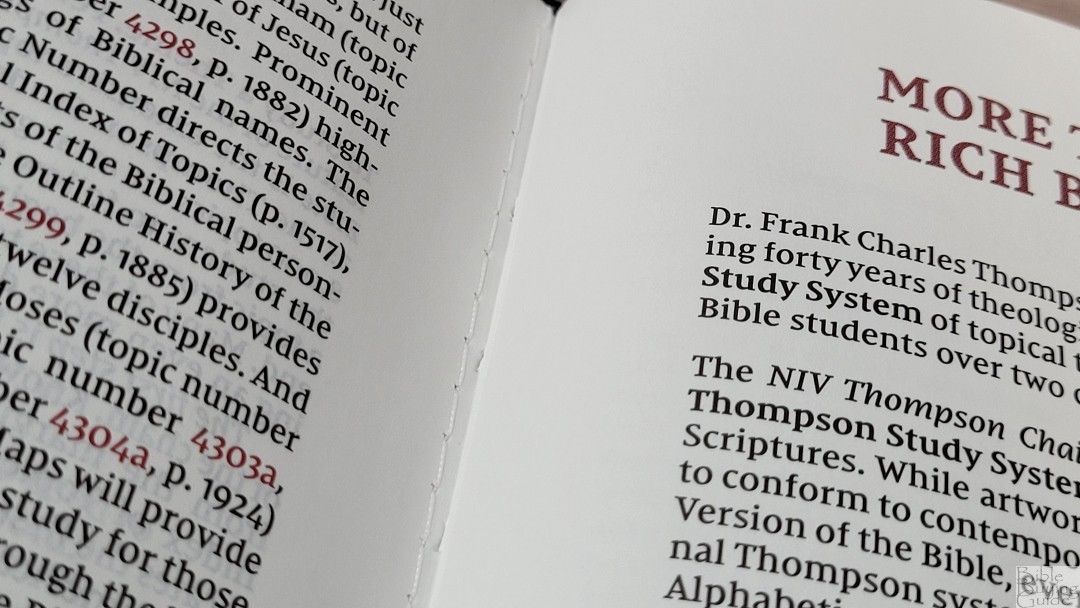
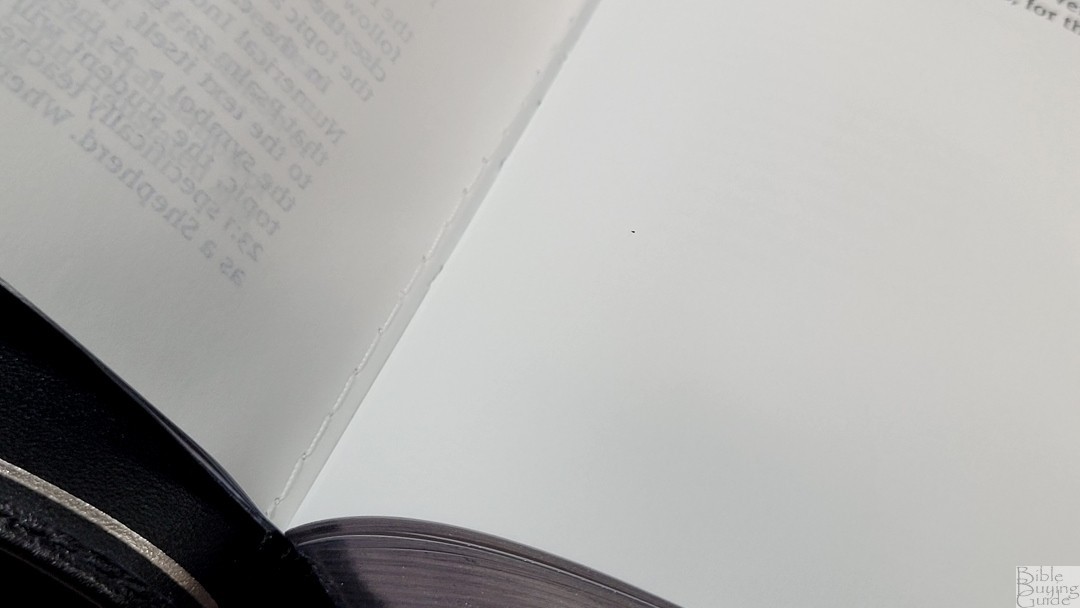
This edition has overcast stitching.
European Paper
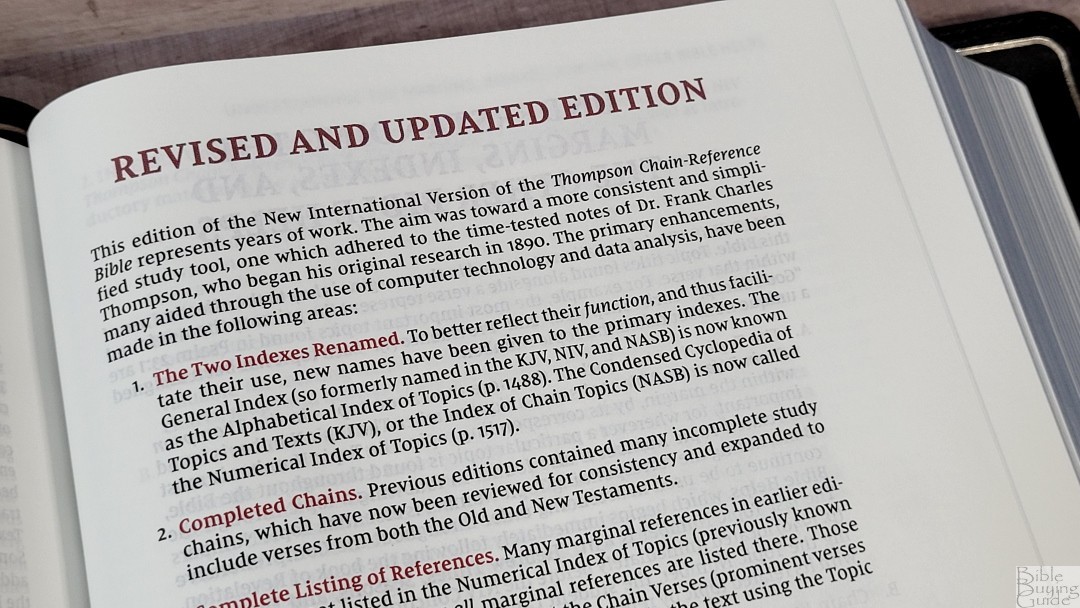
The paper is 36gsm premium European Bible paper. This is the same paper used in all the other Bibles in the Premier Collection. It has a slightly off-white color and it’s highly opaque. It has a smooth texture that’s just rough enough to grab and turn easily. The edges are blue under silver art gilt.
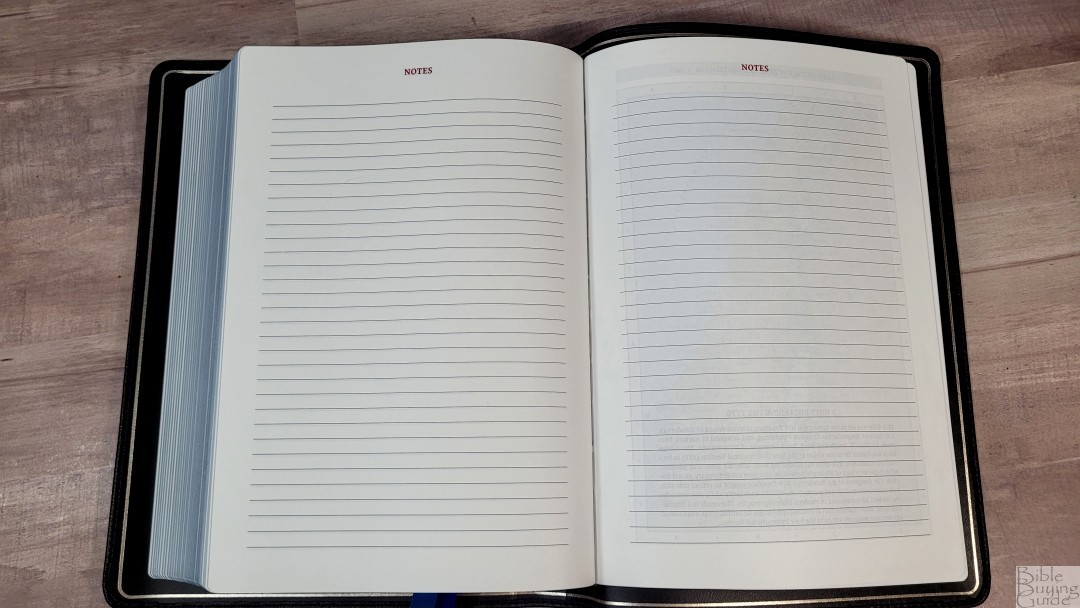
In the back are several pages for notes.
Typography
Note – this information is from the review of the Regular Edition. All the content is the same.
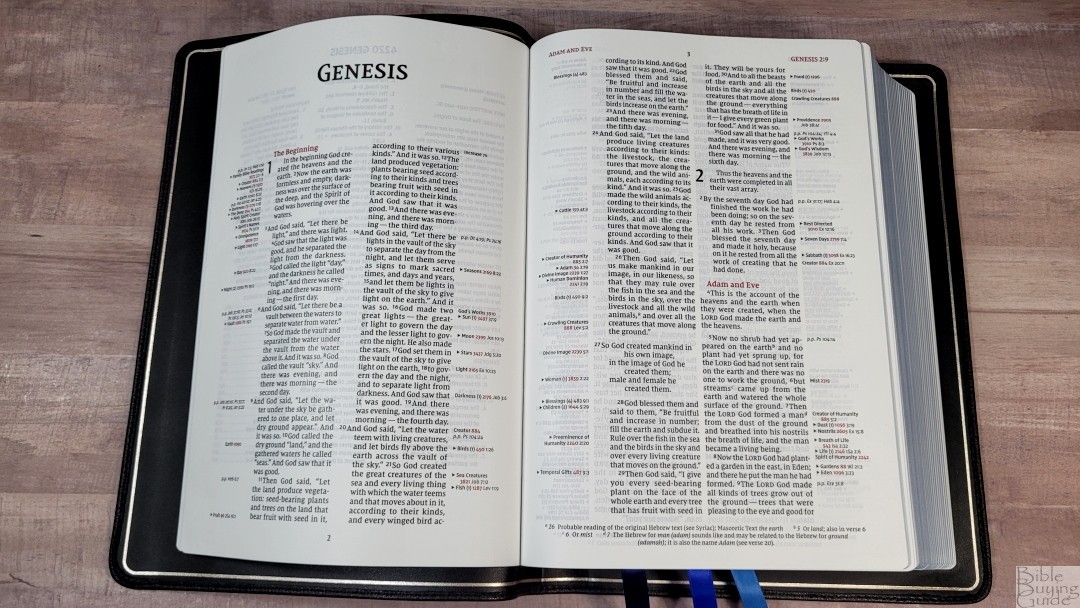
The 2011 NIV text is presented in the standard NIV format with a double-column, paragraph layout, poetry set to stanzas, and letters indented. The Thompson chain reference system is placed in the outer margins next to the verses they correspond to. The NIV footnotes are placed in a single column in the footer. Across the top of the page are the book name, chapter, and verse numbers in red in the outer margin. Page numbers are in black in the center. Page summaries are in red in the inner margin. Section headings are in red. There are no lines dividing the text and chain references.
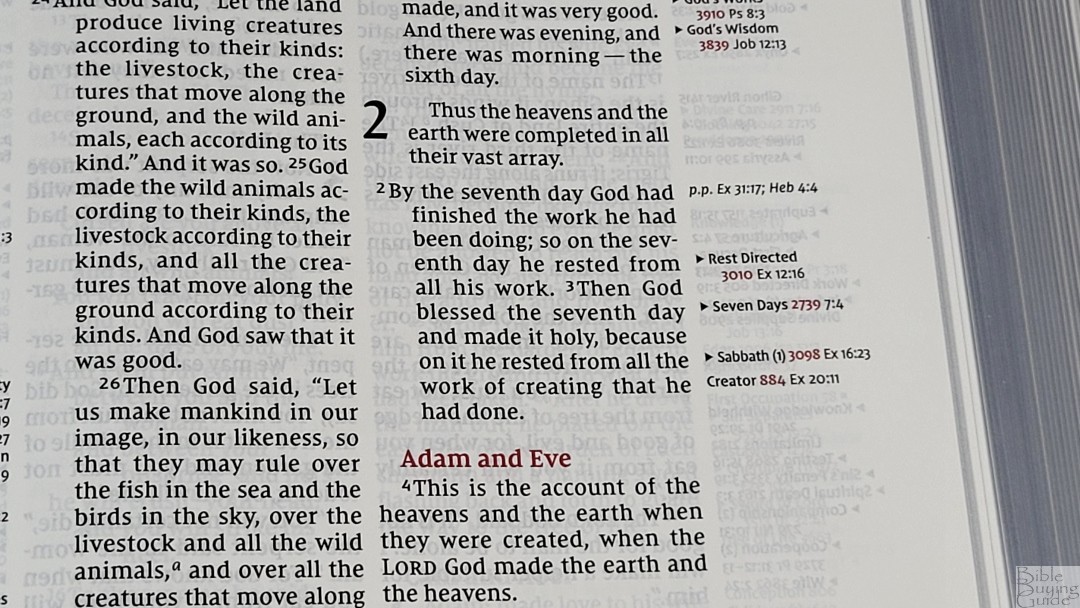
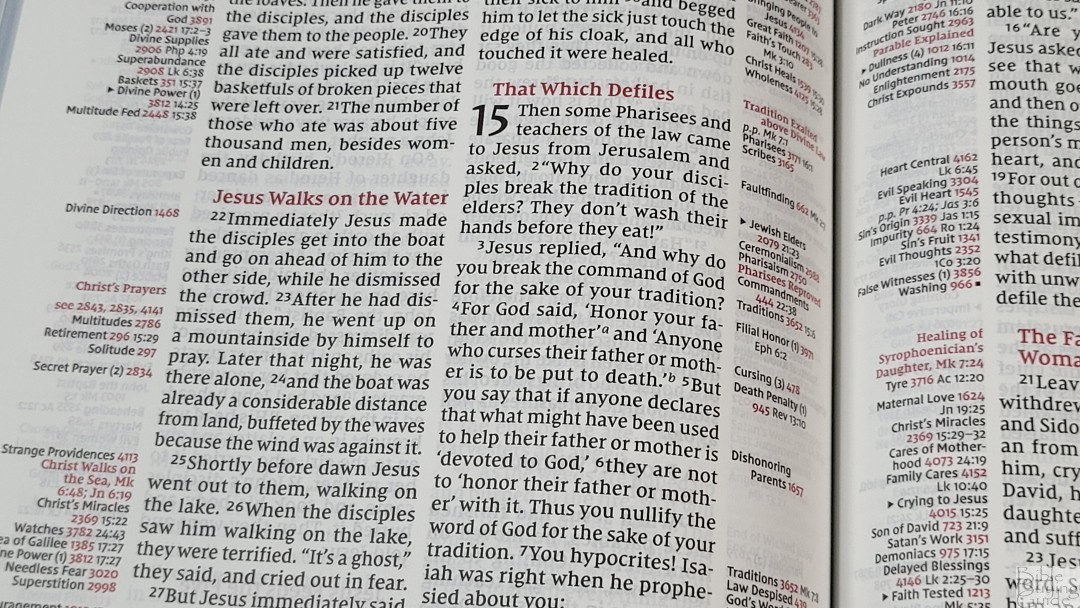
The font is the second generation NIV typeface designed by 2K/Denmark for Zondervan. In other words, the g and o are closed rather than having small openings. The print size for regular edition is 9.5, The black dark and sharp. All editions except for the Premier Collection are red-letter.
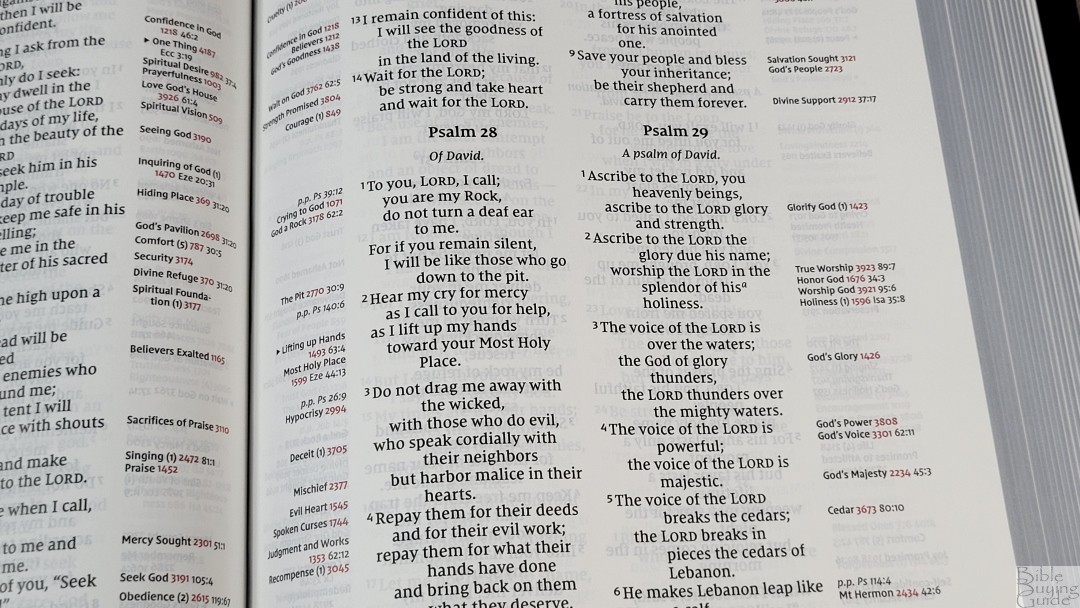
It has 6-7 words per line and extra space between the lines. The NIV text isn’t line-matched, which makes sense for the NIV. Line-matching for the NIV requires special licensing from Biblica, which is difficult to get. They require 1 1/2-spaces for dialog to set it apart. This specification was in place before line-matching existed for Bibles in modern printing. The poetic lines do have a lot of lines with a single word. Verse numbers match the color of the text they’re next to. Although they don’t stand out, they’re large enough to find quickly. The lack of lines dividing the text and references creates a cleaner page. It actually has more space than the original with lines.
References
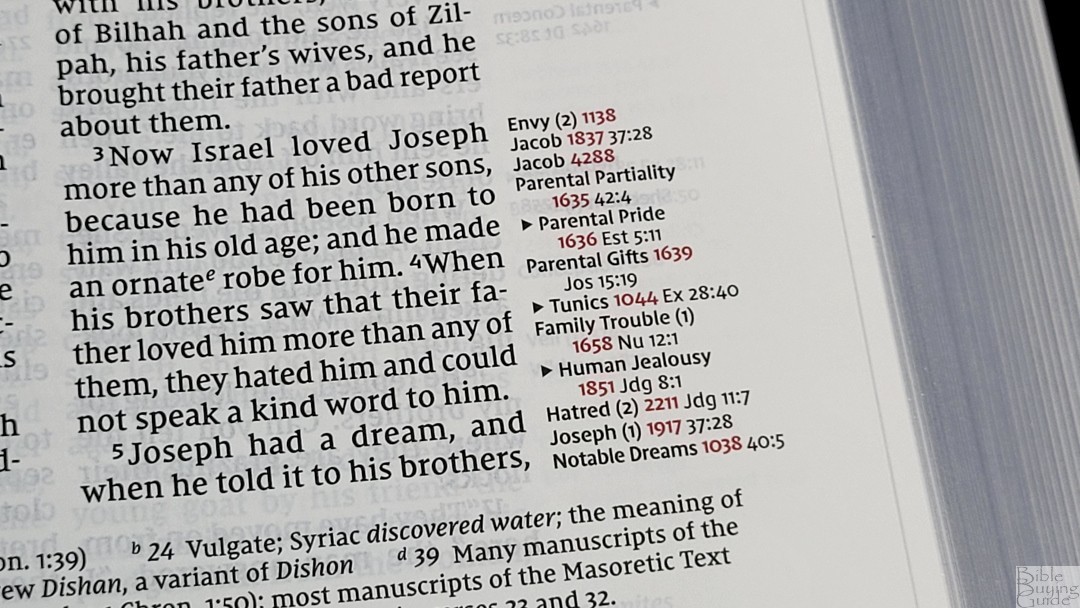
The 100,000 chain references are placed in the margins next to the verses they correspond to. They still work the same as before, but the topic name is now printed first and the number is in red. Triangles indicate the beginning of a chain and squares indicate the end of a chain. It includes parallel passages. All the chains found in the back are completed, so they’re also found in the margins. They’re justified to the text rather than the margins. This points the focus on the text.
Here are a few examples of the margins (the complete list of each topic is found in the Numerical Index in the back). For those where the chain ends in the verses I’m giving I’ve included the topic number.
- Genesis 1:1 – p.p Jn 1:3; Heb 1:10; Family Bible Readings 3:1-6; Creator 2:3; Heavens 1 Chr 16:26
- Deuteronomy 6:4 – One God 32:39
- Isaiah 9:6 – Births Foretold Mt 1:21; Incarnation 11:1; Christ’s Dominion 9:7; Christ’s Wisdom 3838
- Mark 12:29 – The Great Commandment Mt 22:36; Listen and Understand 1185; One God 1 Co 8:4
- John 1:1 – Christ, Eternal 8:58; Christ, “The Word” 1:14; Christ’s Names3632; Christ, Divine Rom 1:4; Christ Eternal 709
- Acts 2:38 – pp Rom 6:4; Promises to Penitent 3:19; Repentance (2) 2707; Repentance (3) 2708; Baptism Directed 10:48; Wonderful Name 2516; Remission of Sin Rom 3:25; Spirit Promised 1603
- Romans 10:9 – Confess Christ Phil 2:11; Christ, Lord 1 Cor 1:9; Faith 2 Tim 3:15; Resurrection 1 Cor 15:4; Salvation 1 Cor 1:21
- 1 John 1:1 – p.p. Lk 24:39; Experience 2030; Witnesses 3855a; Christ the Word Rev 19:13
Book Introductions

The Book Analysis has been moved to the front of each book to create a book introduction. The few lines of introduction that used to be at the beginning of the book have been combined with the introduction. It covers the author, date written, to whom it was written, main theme, key words, key verse, synopsis (a detailed outline), prominent people, and major themes. The list of major chains is new.
I like that the analysis is now an introduction at the beginning of each book. This is the best location for easy access. Many TCR users never knew this material existed because it was in the back and out of the way. It’s now easier to use as an introduction because of the new material and the way it’s formatted.
Comprehensive Bible Helps
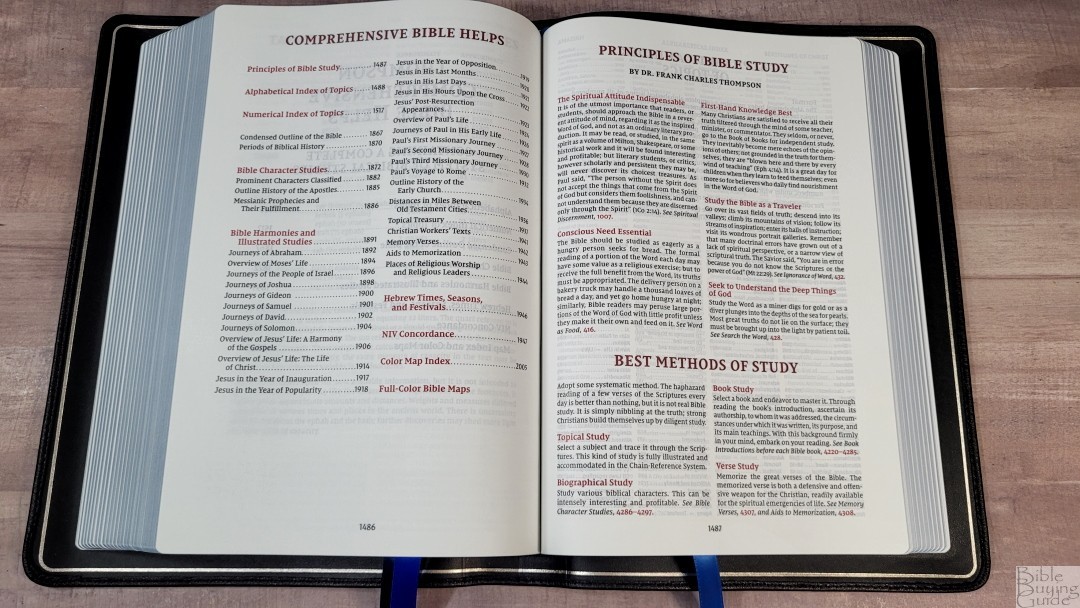
The Comprehensive Helps has been re-typeset and updated. They still include the same information, but they have new graphics and charts, and they’ve been completed, so every table, chart, and maps now have a topical number. The old images have been removed. the Archaeological Supplement has been removed. It was outdated and the least-used featured based on user poles. The topic numbers for the Archaeological Supplement have been assigned to charts and maps that were not numbered before.

Alphabetical Index of Topics – this is the index that you’d use to look up any topic. It provides you with the topic numbers to find in the other resources. It’s printed in three columns per page with the topic number in red. Sub-topics are indented.

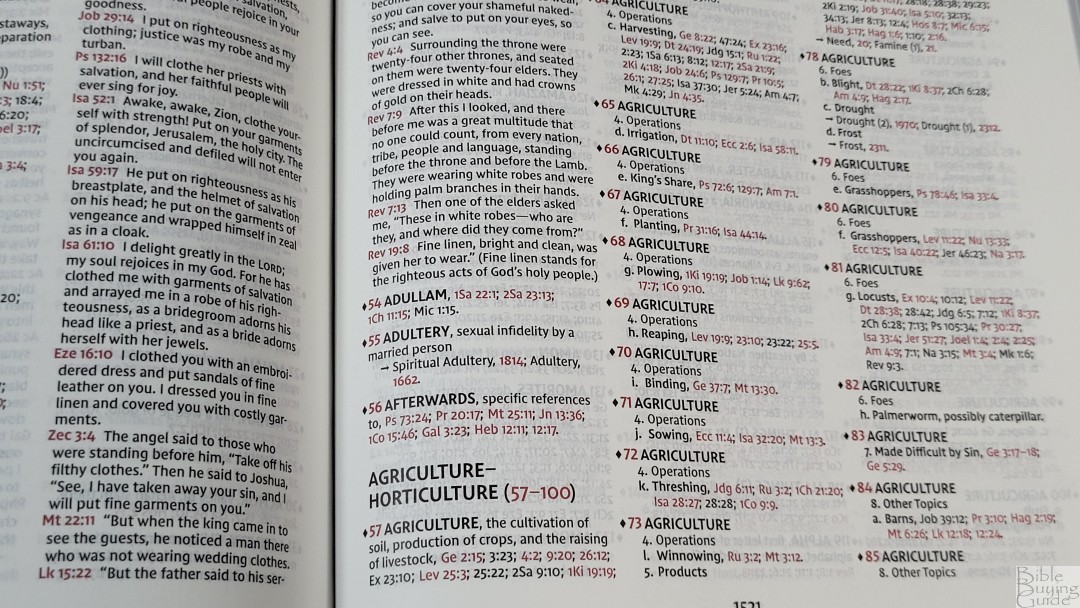
Numerical Index of Topics – this is the main index with every topical chain. It has the topic names, main verses printed in full and their references printed in red, and suggested topics. It’s printed with three columns per page. The topic numbers and prominent verse numbers are printed in red. Topic names are in bold.
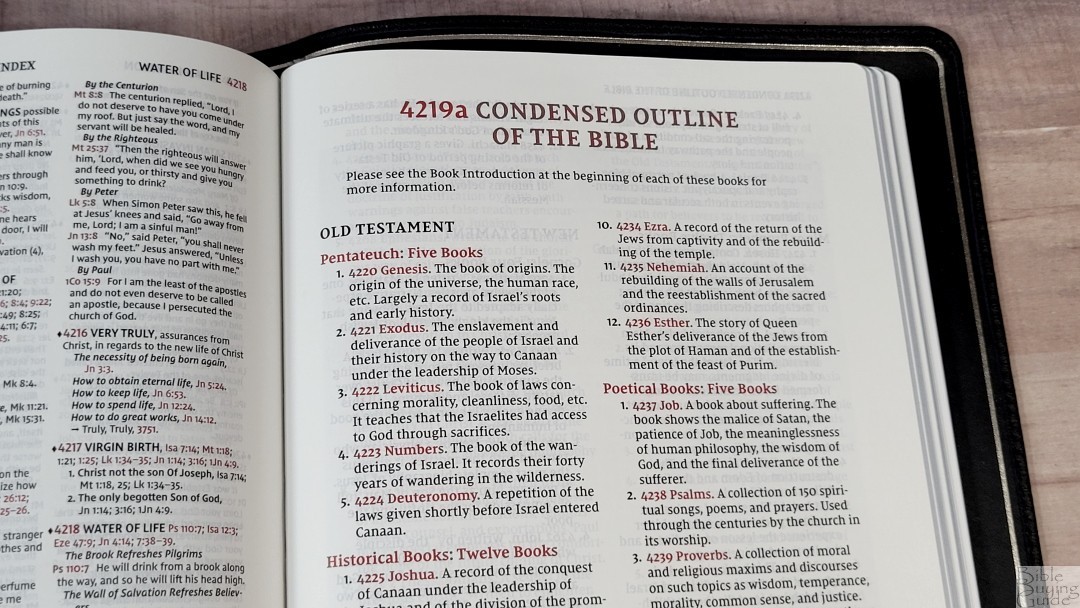
Condensed Outline of the Bible – this is a short description of each book of the Bible. Books are identified according to their genre. Book names and their topic numbers are in red.
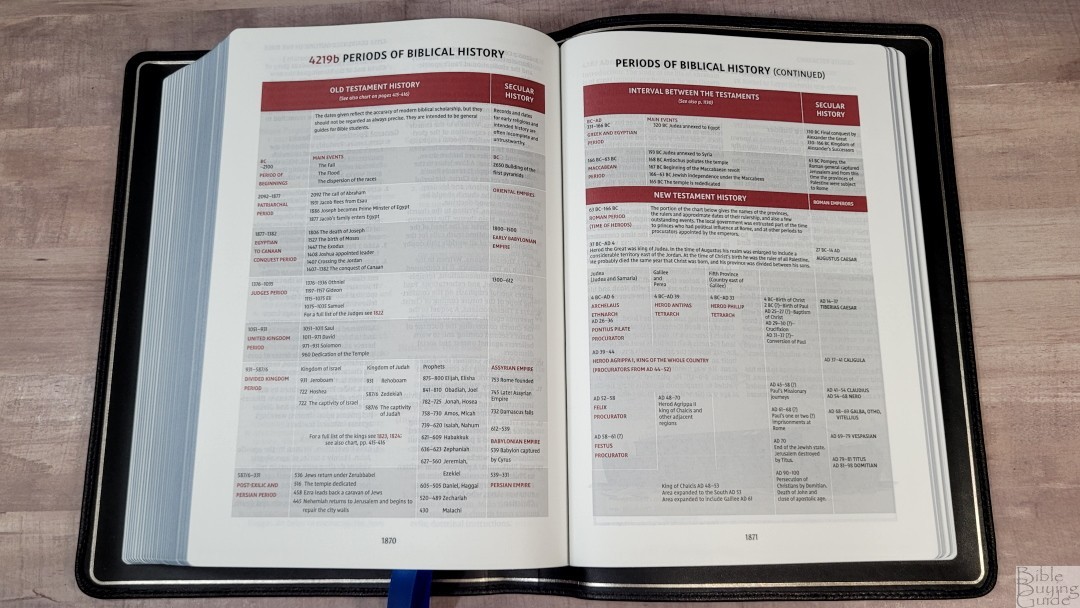
Periods of Biblical History – this is a table that shows the date with OT history and secular history. The tables have a modern design with red titles, alternating gray backgrounds, and red backgrounds for the major titles.
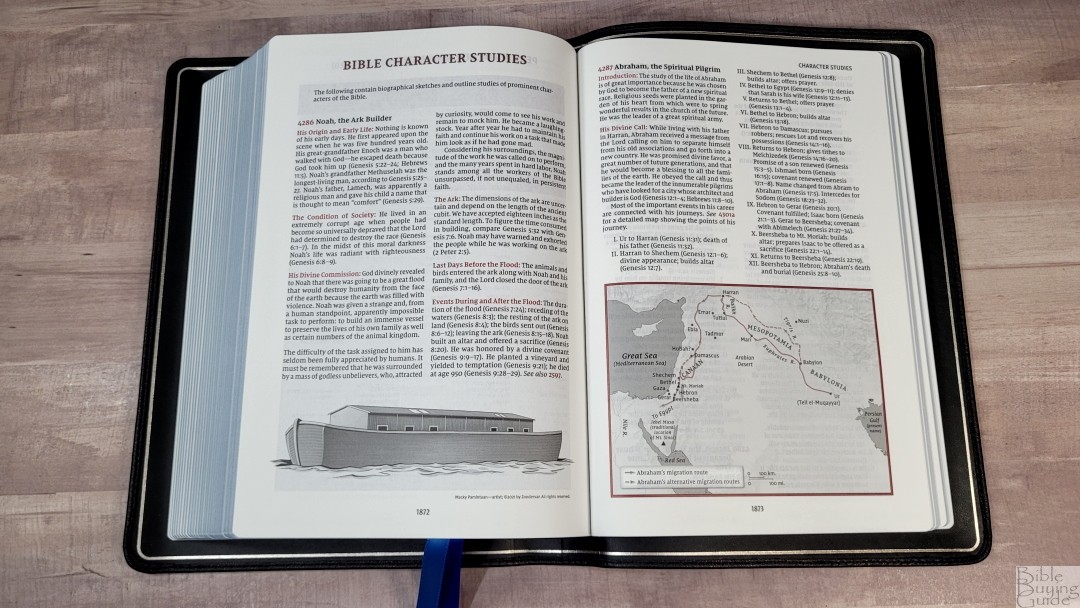
Bible Character Studies – these cover the prominent biblical characters and include maps and outlines. They now have new drawings and maps. Like the other tools, it includes red titles.
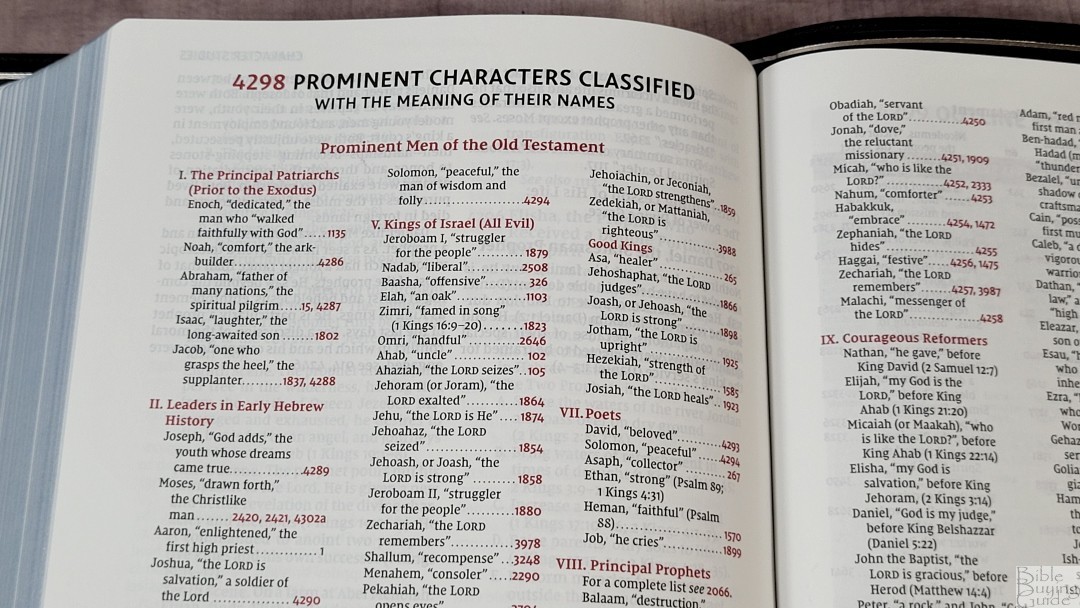
Prominent Characters Classified – this is an outline of the prominent men and women in the Bible. It gives the names with a short description and topic number. This list is provided in outline form with the titles and topic numbers in red.

Outline History of the Apostles – this is a table with the names and information about every apostle.
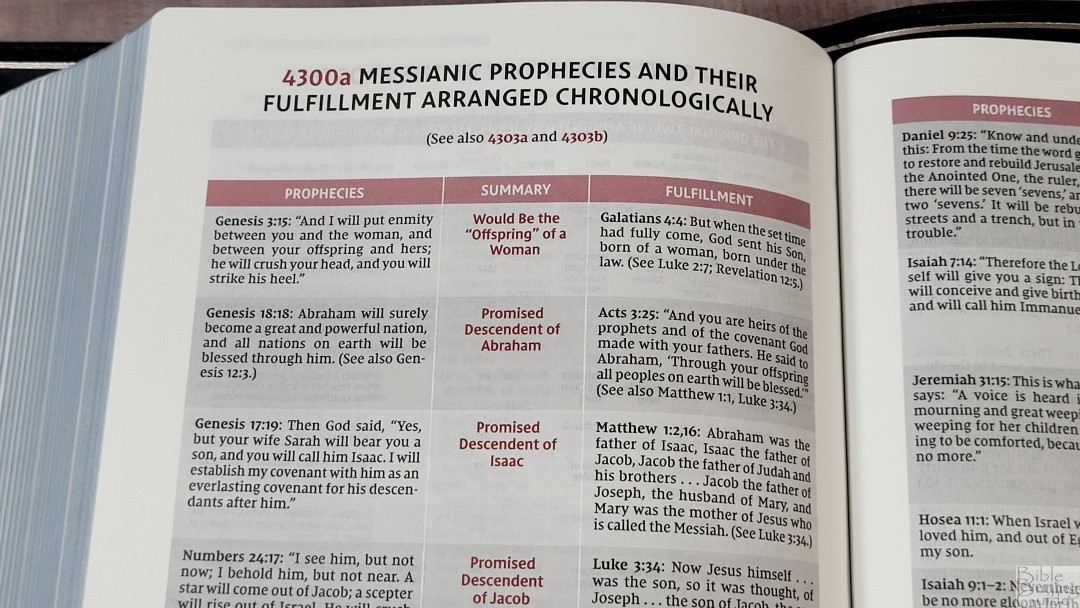
Messianic Prophecies and Their Fulfillment – this is a table with the prophecies, summary, and fulfillment of each Messianic prophecy. Summaries are in red. The backgrounds alternate in different shades of gray.
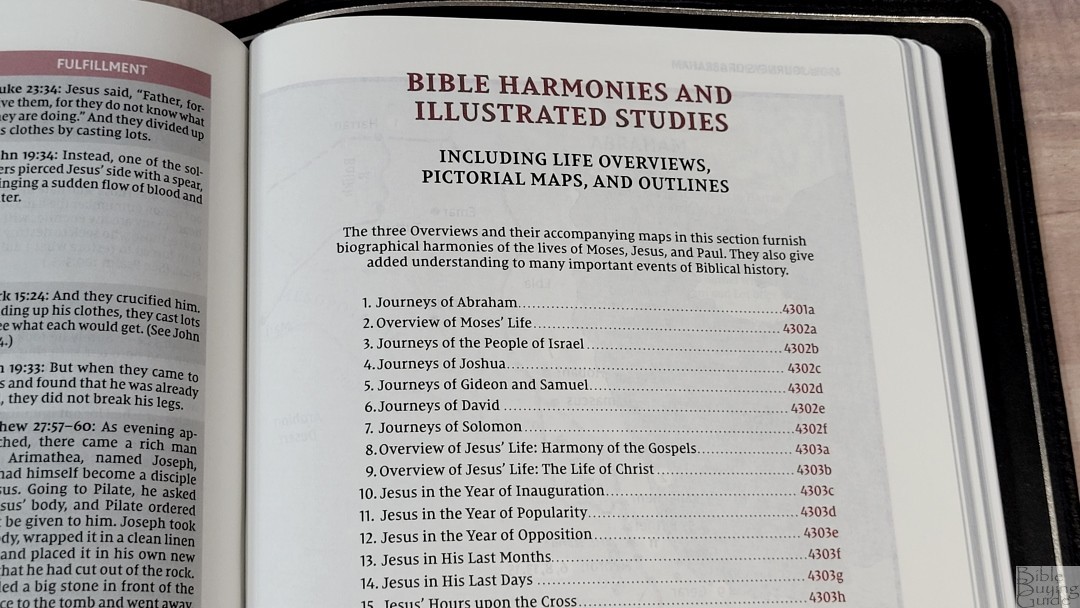

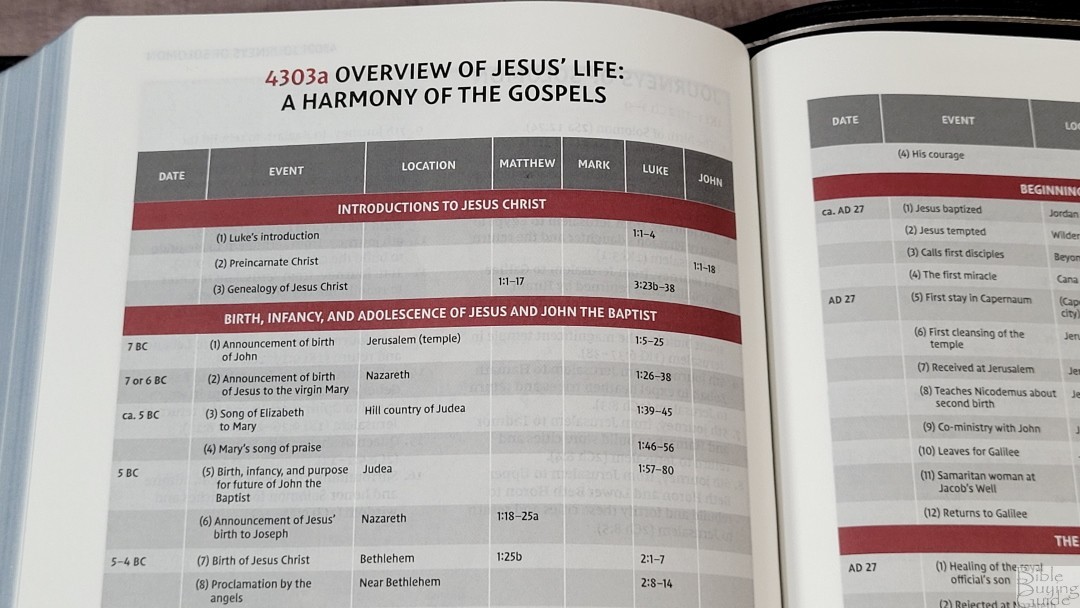
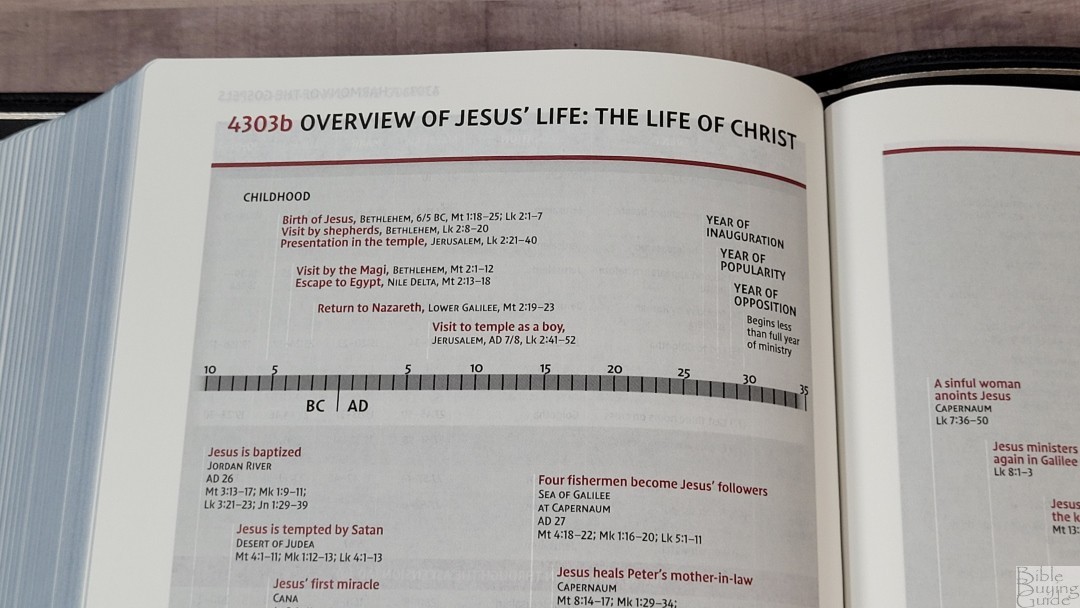

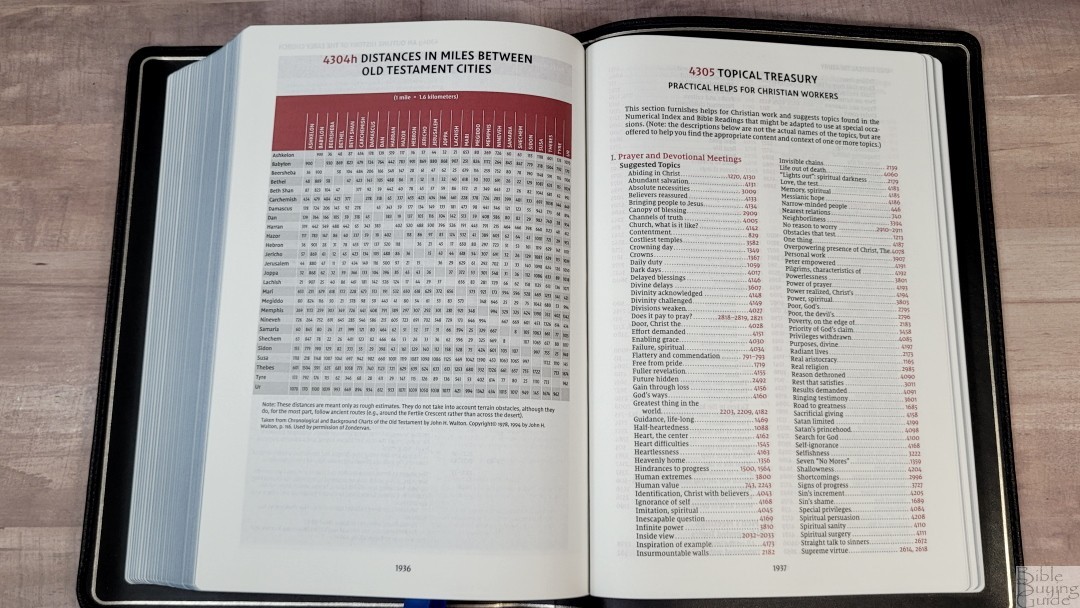
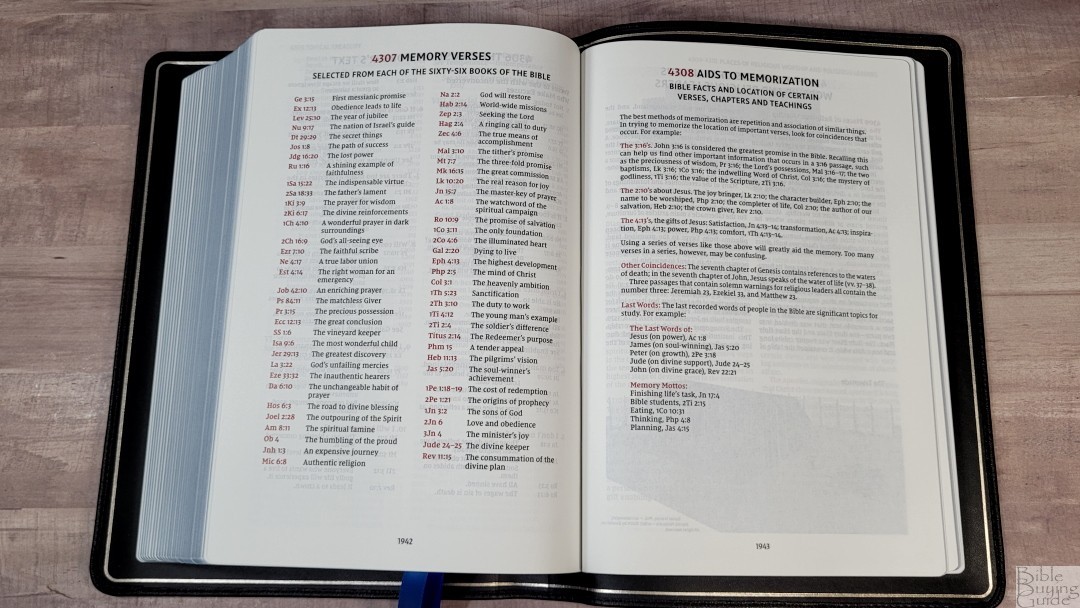
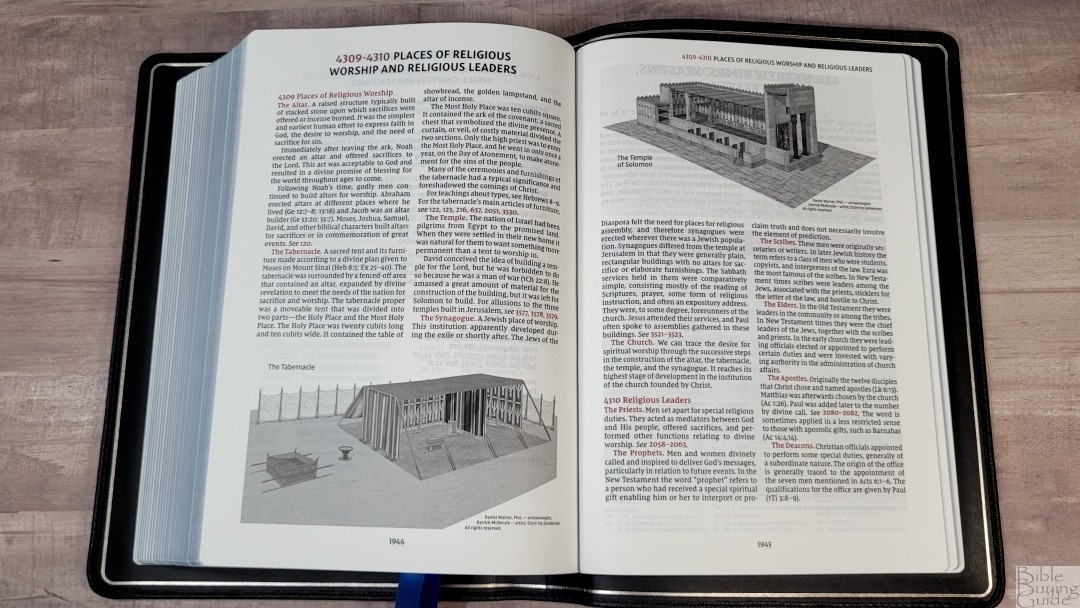
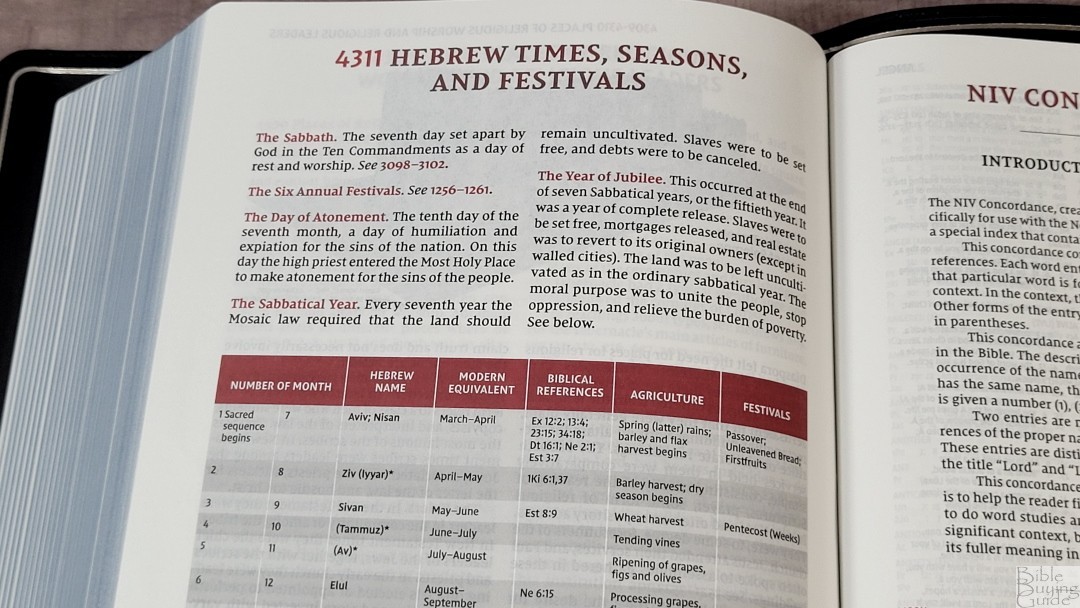
Bible Harmonies and Illustrated Studies – this is a section with life overviews, maps, and outlines of Moses, Jesus, and Paul. It has all-new maps, tables, charts, and graphics. The maps are gray with red highlights. The original had photos of paintings. These have been removed.
Concordance
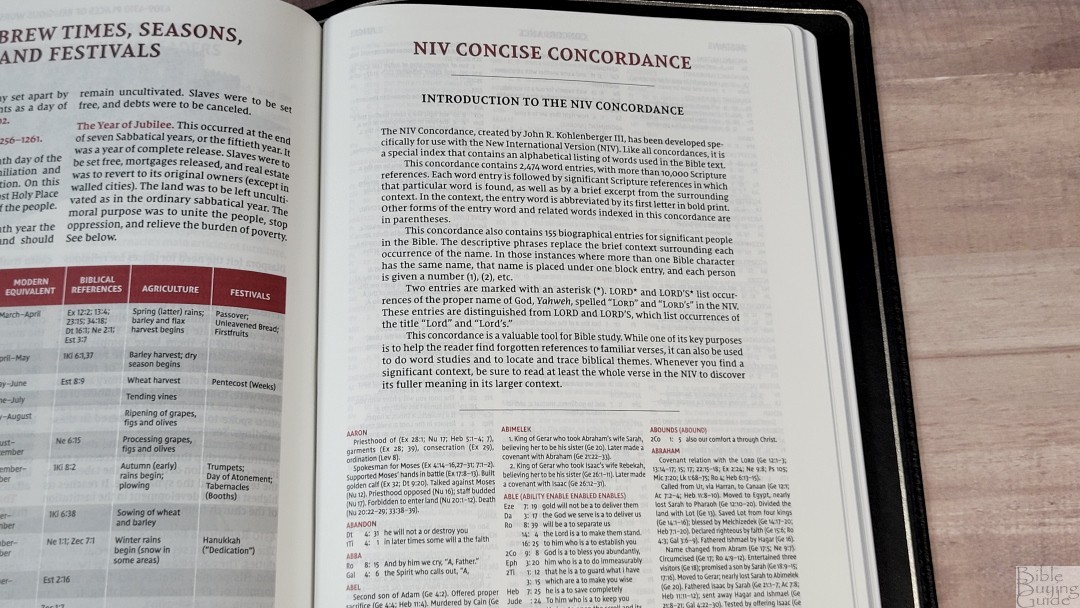
It has a 58-page NIV concordance with 2474 word entries and over 10,000 Scripture references. It includes names with biographical information. This is about a medium size concordance. It’s good for Bible study and sermon prep.
Here are some sample entries with their number of references.
- Christ (Christ’s, Christian, Messiah) – 69
- Christian (Christ) – 1
- Christ’s (Christ) – 3
- Faith (Faithful, Faithfully, Faithfulness, Faithless) – 65
- Faithful (Faith) – 31
- Faithfully (Faith) – 3
- Faithfulness (Faith) – 15
- Faithless (Faith) – 3
- God (God’s, Godliness, Godly, Gods) – 4 columns
- God-breathed (Breathed) – 1
- Godliness (God) – 4
- Godly (God) – 4
- God’s (God) – 28
- Gods (God) – 2
- Jesus – 5 major topics with multiple sub-topics and many Scripture passages and reference within each one
- Life
- Miracles
- Major Teaching
- Parables
- Disciples
- Praise (Praised, Praises, Praising) – 32
- Praised (Praise) – 5
- Praises (Praise) – 4
- Praising (Praise) – 2
- Pray (Prayed, Prayer, Prayers, Praying) – 17
- Prayed (Pray) – 3
- Prayer (Pray) – 13
- Prayers (Pray) – 4
- Praying (Pray) – 4
Maps

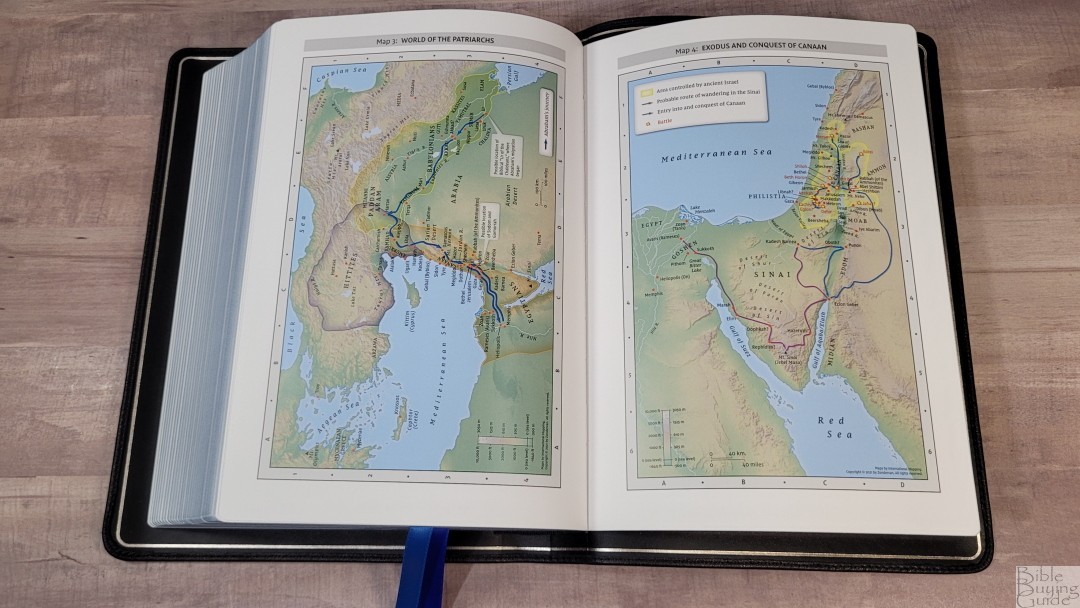
The Kirkbride maps have been replaced with 13 Zondervan maps. They’re printed on thick, semi-glossy paper. The maps include topography, elevation, distance, routes, borders, possible locations of lost places, battles, cities, cities of refuge, empires with dates, locations of events of prophets, locations for the events of Jesus’ ministry, and locations for the events of the apostles and missionaries.

It also includes a large index to maps with 6 divisions.
Maps include:
- Archaeological Sites in Ancient Israel
- Archaeological Sites in the Bible Lands
- World of the Patriarchs
- Exodus and Conquest of Canaan
- Land of the Twelve Tribes
- Kingdom of David and Solomon
- Kingdoms of Israel and Judah
- Assyrian and Babylonian Empires
- Holy Land in the Time of Jesus
- Jerusalem in the Time of Jesus
- Paul’s Missionary Journeys
- Roman Empire
- Apostle’s Early Travels
Comparing with the Regular Edition
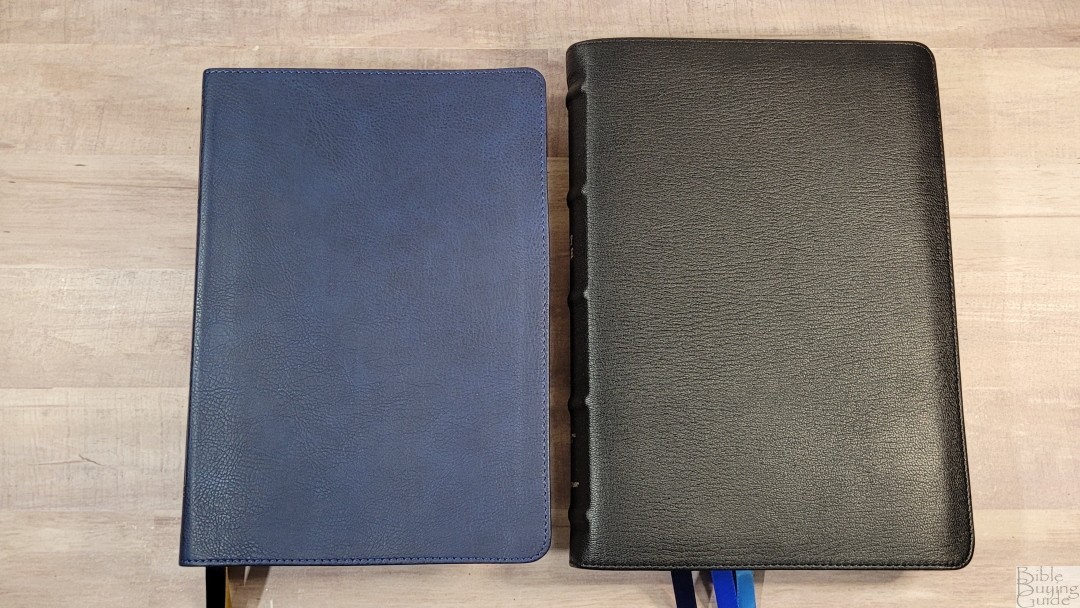
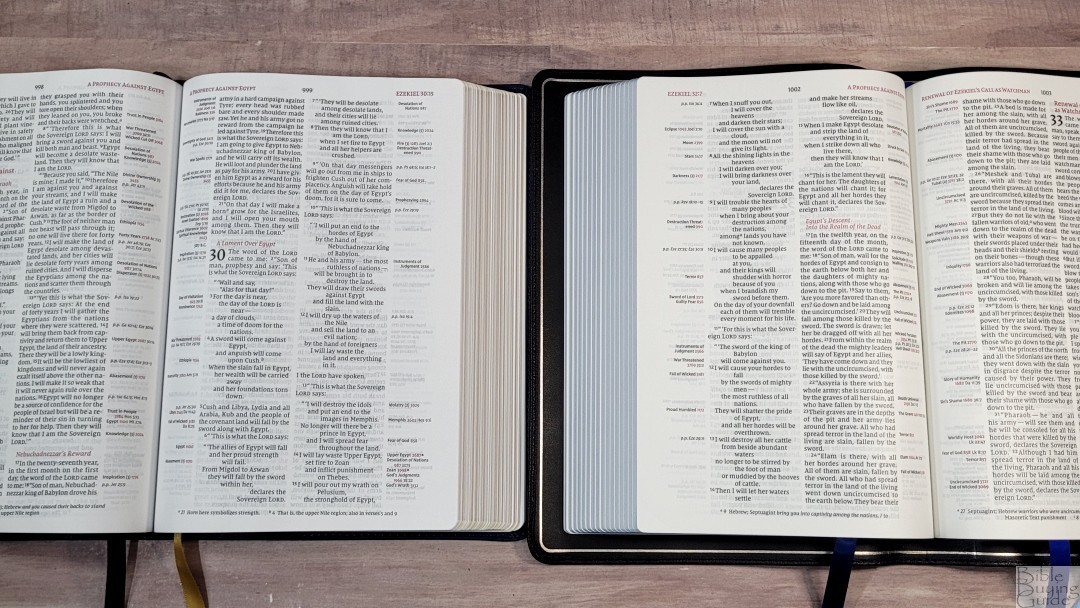

The regular edition has 30gsm paper. The show-through isn’t bad, but it’s more noticeable than the 36gsm of the Premier Collection. It also has 2 ribbons and is available;e in hardcover, Leathersoft, and genuine leather. I like all of them, but the Premier Collection is my favorite.
Conclusion

Zondervan’s updated version of the Thompson Chain Reference Bible is an excellent update to the original. I like that it’s available in such a wide range of cover options. The Premier Collection’s cover looks and feels elegant. The 36gsm paper alone makes this my favorite version of the Comfort Print TCRs. If you’re interested in a high-quality version of the NIV TCR, this is the one I recommend. I’m looking forward to seeing the Comfort Print TCR in the Premier Collection for all translations.
_________________________________________________________
This Bible is available from
Church Source (available soon)
_________________________________________________________
Zondervan provided these Bibles in exchange for an honest review. I was not required to give a positive review, only an honest one. All opinions are my own.


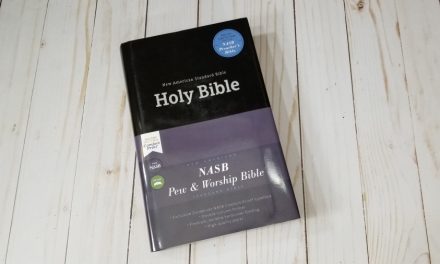

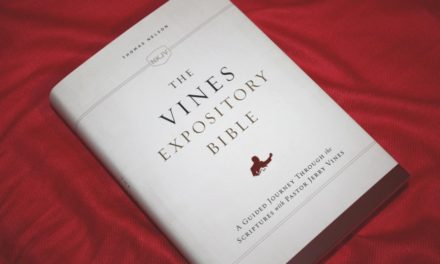






Hi Randy and thanks for these three great reviews of the new Thompson Chain NIV in various editions. And do you know whether they’re also going to do a large print version in the Premier Collection?
Great reviews Randy! I’d like to purchase the NIV Thompson premium edition but I prefer large print. Is the same paper used in the large print cowhide edition as the paper used in the premium edition? I saw the large print cowhide edition in a bookstore and the paper seemed very nice. But how does it compare to he premium editions? Thank you!